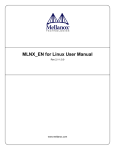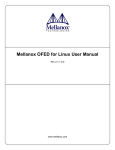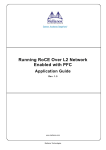Download MLNX_EN for Linux User Manual
Transcript
MLNX_EN for Linux User Manual
Rev 2.0-3.0.0
Last Modified: October 07, 2013
www.mellanox.com
Rev 2.0-3.0.0
NOTE:
THIS HARDWARE, SOFTWARE OR TEST SUITE PRODUCT (“PRODUCT(S)”) AND ITS RELATED
DOCUMENTATION ARE PROVIDED BY MELLANOX TECHNOLOGIES “AS-IS” WITH ALL FAULTS OF ANY
KIND AND SOLELY FOR THE PURPOSE OF AIDING THE CUSTOMER IN TESTING APPLICATIONS THAT USE
THE PRODUCTS IN DESIGNATED SOLUTIONS. THE CUSTOMER'S MANUFACTURING TEST ENVIRONMENT
HAS NOT MET THE STANDARDS SET BY MELLANOX TECHNOLOGIES TO FULLY QUALIFY THE
PRODUCTO(S) AND/OR THE SYSTEM USING IT. THEREFORE, MELLANOX TECHNOLOGIES CANNOT AND
DOES NOT GUARANTEE OR WARRANT THAT THE PRODUCTS WILL OPERATE WITH THE HIGHEST
QUALITY. ANY EXPRESS OR IMPLIED WARRANTIES, INCLUDING, BUT NOT LIMITED TO, THE IMPLIED
WARRANTIES OF MERCHANTABILITY, FITNESS FOR A PARTICULAR PURPOSE AND NONINFRINGEMENT
ARE DISCLAIMED. IN NO EVENT SHALL MELLANOX BE LIABLE TO CUSTOMER OR ANY THIRD PARTIES
FOR ANY DIRECT, INDIRECT, SPECIAL, EXEMPLARY, OR CONSEQUENTIAL DAMAGES OF ANY KIND
(INCLUDING, BUT NOT LIMITED TO, PAYMENT FOR PROCUREMENT OF SUBSTITUTE GOODS OR SERVICES;
LOSS OF USE, DATA, OR PROFITS; OR BUSINESS INTERRUPTION) HOWEVER CAUSED AND ON ANY
THEORY OF LIABILITY, WHETHER IN CONTRACT, STRICT LIABILITY, OR TORT (INCLUDING NEGLIGENCE
OR OTHERWISE) ARISING IN ANY WAY FROM THE USE OF THE PRODUCT(S) AND RELATED
DOCUMENTATION EVEN IF ADVISED OF THE POSSIBILITY OF SUCH DAMAGE.
Mellanox Technologies
350 Oakmead Parkway Suite 100
Sunnyvale, CA 94085
U.S.A.
www.mellanox.com
Tel: (408) 970-3400
Fax: (408) 970-3403
Mellanox Technologies, Ltd.
Beit Mellanox
PO Box 586 Yokneam 20692
Israel
www.mellanox.com
Tel: +972 (0)74 723 7200
Fax: +972 (0)4 959 3245
© Copyright 2013. Mellanox Technologies. All Rights Reserved.
Mellanox®, Mellanox logo, BridgeX®, ConnectX®, CORE-Direct®, InfiniBridge®, InfiniHost®, InfiniScale®,
MLNX-OS®, PhyX®, SwitchX®, UFM®, Virtual Protocol Interconnect® and Voltaire® are registered trademarks of
Mellanox Technologies, Ltd.
Connect-IB™, ExtendX™, FabricIT™, Mellanox Open Ethernet™, Mellanox Virtual Modular Switch™, MetroX™,
MetroDX™, ScalableHPC™, Unbreakable-Link™ are trademarks of Mellanox Technologies, Ltd.
All other trademarks are property of their respective owners.
2
Mellanox Technologies
Document Number: 2950
Rev 2.0-3.0.0
Table of Contents
Table of Contents . . . . . . . . . . . . . . . . . . . . . . . . . . . . . . . . . . . . . . . . . . . . . . . . . . . . . . . . . . 3
List of Tables . . . . . . . . . . . . . . . . . . . . . . . . . . . . . . . . . . . . . . . . . . . . . . . . . . . . . . . . . . . . . 5
Chapter 1 Overview . . . . . . . . . . . . . . . . . . . . . . . . . . . . . . . . . . . . . . . . . . . . . . . . . . . . . . . 6
1.1
Package Contents. . . . . . . . . . . . . . . . . . . . . . . . . . . . . . . . . . . . . . . . . . . . . . . . . . 6
Chapter 2 Driver Installation . . . . . . . . . . . . . . . . . . . . . . . . . . . . . . . . . . . . . . . . . . . . . . . 8
2.1
2.2
2.3
2.4
2.5
Software Dependencies . . . . . . . . . . . . . . . . . . . . . . . . . . . . . . . . . . . . . . . . . . . . .
Installing the Driver . . . . . . . . . . . . . . . . . . . . . . . . . . . . . . . . . . . . . . . . . . . . . . . .
Loading the Driver. . . . . . . . . . . . . . . . . . . . . . . . . . . . . . . . . . . . . . . . . . . . . . . . .
Unloading the Driver . . . . . . . . . . . . . . . . . . . . . . . . . . . . . . . . . . . . . . . . . . . . . . .
Uninstalling the Driver . . . . . . . . . . . . . . . . . . . . . . . . . . . . . . . . . . . . . . . . . . . . .
8
8
9
9
9
Chapter 3 Ethernet Driver Usage and Configuration . . . . . . . . . . . . . . . . . . . . . . . . . . 10
Chapter 4 Firmware Programming . . . . . . . . . . . . . . . . . . . . . . . . . . . . . . . . . . . . . . . . . 12
4.1
4.2
Installing Firmware Tools . . . . . . . . . . . . . . . . . . . . . . . . . . . . . . . . . . . . . . . . . . 12
Updating Adapter Card Firmware . . . . . . . . . . . . . . . . . . . . . . . . . . . . . . . . . . . . 12
Chapter 5 Driver Features . . . . . . . . . . . . . . . . . . . . . . . . . . . . . . . . . . . . . . . . . . . . . . . . 13
5.1
Quality of Service . . . . . . . . . . . . . . . . . . . . . . . . . . . . . . . . . . . . . . . . . . . . . . . . 13
5.1.1
5.1.2
5.1.3
5.1.4
5.1.5
5.2
Mapping Traffic to Traffic Classes . . . . . . . . . . . . . . . . . . . . . . . . . . . . . . . . . . . .
Plain Ethernet Quality of Service Mapping . . . . . . . . . . . . . . . . . . . . . . . . . . . . .
Map Priorities with tc_wrap.py/mlnx_qos . . . . . . . . . . . . . . . . . . . . . . . . . . . . . .
Quality of Service Properties . . . . . . . . . . . . . . . . . . . . . . . . . . . . . . . . . . . . . . . .
Quality of Service Tools . . . . . . . . . . . . . . . . . . . . . . . . . . . . . . . . . . . . . . . . . . . .
13
13
14
14
15
Time-Stamping Service . . . . . . . . . . . . . . . . . . . . . . . . . . . . . . . . . . . . . . . . . . . . 19
5.2.1 Enabling Time Stamping. . . . . . . . . . . . . . . . . . . . . . . . . . . . . . . . . . . . . . . . . . . . 20
5.2.2 Getting Time Stamping . . . . . . . . . . . . . . . . . . . . . . . . . . . . . . . . . . . . . . . . . . . . . 21
5.3
Flow Steering. . . . . . . . . . . . . . . . . . . . . . . . . . . . . . . . . . . . . . . . . . . . . . . . . . . . 22
5.3.1 Enable/Disable Flow Steering. . . . . . . . . . . . . . . . . . . . . . . . . . . . . . . . . . . . . . . . 22
5.3.2 Flow Domains and Priorities. . . . . . . . . . . . . . . . . . . . . . . . . . . . . . . . . . . . . . . . . 22
5.4
Single Root IO Virtualization (SR-IOV) . . . . . . . . . . . . . . . . . . . . . . . . . . . . . . . 24
5.4.1
5.4.2
5.4.3
5.4.4
5.4.5
5.4.6
5.4.7
System Requirements . . . . . . . . . . . . . . . . . . . . . . . . . . . . . . . . . . . . . . . . . . . . . .
Setting Up SR-IOV . . . . . . . . . . . . . . . . . . . . . . . . . . . . . . . . . . . . . . . . . . . . . . . .
Enabling SR-IOV and Para Virtualization on the Same Setup . . . . . . . . . . . . . . .
Assigning a Virtual Function to a Virtual Machine . . . . . . . . . . . . . . . . . . . . . . .
Uninstalling SR-IOV Driver . . . . . . . . . . . . . . . . . . . . . . . . . . . . . . . . . . . . . . . . .
Burning Firmware with SR-IOV. . . . . . . . . . . . . . . . . . . . . . . . . . . . . . . . . . . . . .
Ethernet Virtual Function Configuration when Running SR-IOV . . . . . . . . . . . .
24
25
28
30
31
31
32
Chapter 6 Performance Tuning . . . . . . . . . . . . . . . . . . . . . . . . . . . . . . . . . . . . . . . . . . . . 35
6.1
6.2
Increasing Packet Rate. . . . . . . . . . . . . . . . . . . . . . . . . . . . . . . . . . . . . . . . . . . . . 35
General System Configurations . . . . . . . . . . . . . . . . . . . . . . . . . . . . . . . . . . . . . . 35
6.2.1 PCI Express (PCIe) Capabilities . . . . . . . . . . . . . . . . . . . . . . . . . . . . . . . . . . . . . . 35
6.2.2 Memory Configuration . . . . . . . . . . . . . . . . . . . . . . . . . . . . . . . . . . . . . . . . . . . . . 35
6.2.3 Recommended BIOS Settings. . . . . . . . . . . . . . . . . . . . . . . . . . . . . . . . . . . . . . . . 36
Mellanox Technologies
3
Rev 2.0-3.0.0
6.3
Performance Tuning for Linux . . . . . . . . . . . . . . . . . . . . . . . . . . . . . . . . . . . . . . 38
6.3.1
6.3.2
6.3.3
6.3.4
6.3.5
6.3.6
6.3.7
6.3.8
4
Tuning the Network Adapter for Improved IPv4 Traffic Performance . . . . . . . .
Tuning the Network Adapter for Improved IPv6 Traffic Performance . . . . . . . .
Preserving Your Performance Settings after a Reboot . . . . . . . . . . . . . . . . . . . . .
Tuning Power Management . . . . . . . . . . . . . . . . . . . . . . . . . . . . . . . . . . . . . . . . .
Interrupt Moderation . . . . . . . . . . . . . . . . . . . . . . . . . . . . . . . . . . . . . . . . . . . . . . .
Tuning for NUMA Architecture . . . . . . . . . . . . . . . . . . . . . . . . . . . . . . . . . . . . . .
IRQ Affinity . . . . . . . . . . . . . . . . . . . . . . . . . . . . . . . . . . . . . . . . . . . . . . . . . . . . .
Tuning Multi-Threaded IP Forwarding. . . . . . . . . . . . . . . . . . . . . . . . . . . . . . . . .
Mellanox Technologies
38
39
39
39
41
41
43
45
Rev 2.0-3.0.0
List of Tables
Table 1:
Table 2:
Table 3:
Table 4:
Table 5:
Table 6:
MLNX_EN Package Content . . . . . . . . . . . . . . . . . . . . . . . . . . . . . . . . . . . . . . . . . . . . . . . 6
Flow Specific Parameters . . . . . . . . . . . . . . . . . . . . . . . . . . . . . . . . . . . . . . . . . . . . . . . . . 23
Recommended PCIe Configuration. . . . . . . . . . . . . . . . . . . . . . . . . . . . . . . . . . . . . . . . . . 35
Recommended BIOS Settings for Intel Sandy Bridge Processors . . . . . . . . . . . . . . . . . . 36
Recommended BIOS Settings for Intel® Nehalem/Westmere Processors . . . . . . . . . . . . 37
Recommended BIOS Settings for AMD Processors . . . . . . . . . . . . . . . . . . . . . . . . . . . . . 37
Mellanox Technologies
5
Rev 2.0-3.0.0
1
Overview
Overview
This document provides information on the MLNX_EN Linux driver and instructions for installing the driver on Mellanox ConnectX adapter cards supporting 10Gb/s and 40Gb/s Ethernet.
The MLNX_EN driver release exposes the following capabilities:
1.1
•
Single/Dual port
•
Up to 16 Rx queues per port
•
16 Tx queues per port
•
Rx steering mode: Receive Core Affinity (RCA)
•
MSI-X or INTx
•
Adaptive interrupt moderation
•
HW Tx/Rx checksum calculation
•
Large Send Offload (i.e., TCP Segmentation Offload)
•
Large Receive Offload
•
Multi-core NAPI support
•
VLAN Tx/Rx acceleration (HW VLAN stripping/insertion)
•
Ethtool support
•
Net device statistics
•
SR-IOV support
•
Flow steering
•
Ethernet Time Stamping (at beta level)
Package Contents
This driver kit contains the following:
Table 1 - MLNX_EN Package Content
Components
6
Description
mlx4 driver
mlx4 is the low level driver implementation for the ConnectX adapters designed
by Mellanox Technologies. The ConnectX can operate as an InfiniBand adapter
and as an Ethernet NIC.
To accommodate the two flavors, the driver is split into modules: mlx4_core,
mlx4_en, and mlx4_ib.
Note: mlx4_ib is not part of this package.
mlx4_core
Handles low-level functions like device initialization and firmware commands
processing. Also controls resource allocation so that the InfiniBand, Ethernet and
FC functions can share a device without interfering with each other.
mlx4_en
Handles Ethernet specific functions and plugs into the netdev mid-layer.
mstflint
An application to burn a firmware binary image.
Software modules
Sources of all software modules (under conditions mentioned in the modules'
LICENSE files)
Mellanox Technologies
Rev 2.0-3.0.0
Table 1 - MLNX_EN Package Content
Components
Documentation
Description
Release Notes, README
Mellanox Technologies
7
Rev 2.0-3.0.0
Driver Installation
2
Driver Installation
2.1
Software Dependencies
2.2
•
To install the driver software, kernel sources must be installed on the machine.
•
MLNX_EN driver cannot coexist with OFED software on the same machine. Hence
when installing MLNX_EN all OFED packages should be removed (done by the
mlnx_en install script).
Installing the Driver
Step 1.
Download Driver Package from the Mellanox site.
http://www.mellanox.com/content/
pages.php?pg=products_dyn&product_family=27&menu_section=35
Step 2.
Install Driver.
#> tar xzvf mlnx_en-2.0-3.0.0.tgz file
#> cd mlnx_en-2.0-3.0.0
#> ./install.sh
To install mlnx-en-2.0-3.0.0 on XenServer6.1:
# rpm -ihv RPMS/xenserver6u1/i386/`uname -r`/mlnx_en*rpm
The package consists of several source RPMs. The install script rebuilds the source RPMs and
then installs the created binary RPMs. The created kernel module binaries are located at:
•
For KMP RPMs installation:
• On SLES (mellanox-mlnx-en-kmp RPM):
/lib/modules/<kernel-ver>/updates/mellanox-mlnx-en
• On RHEL (kmod-mellanox-mlnx-en RPM):
/lib/modules/<kernel-ver>/extra/mellanox-mlnx-en
•
For non-KMP RPMs (mlnx_en RPM):
• On SLES:
/lib/modules/<kernel-ver>/updates/mlnx_en
• On RHE:
/lib/modules/<kernel-ver>/extra/mlnx_en
mlnx_en installer supports 2 modes of installation. The install scripts selects the mode of driver
installation depending of the running OS/kernel version.
•
Kernel Module Packaging (KMP) mode, where the source rpm is rebuilt for each
installed flavor of the kernel. This mode is used for RedHat and SUSE distributions.
•
Non KMP installation mode, where the sources are rebuilt with the running kernel. This
mode is used for vanilla kernels.
If the Vanilla kernel is installed as rpm, please use the "--disable-kmp" flag when
installing the driver.
8
Mellanox Technologies
Rev 2.0-3.0.0
The kernel module sources are placed under /usr/src/mellanox-mlnx-en-2.0/.
To recompile the driver:
#>
#>
#>
#>
cd /usr/src/mellanox-mlnx-en-2.0/
scripts/mlnx_en_patch.sh
make
make install
The uninstall and performance tuning scripts are installed.
If the driver was installed without kmp support, the sources would be located under /
usr/srs/mlnx_en-2.0/.
2.3
Loading the Driver
Step 1.
Make sure no previous driver version is currently loaded.
#> modprobe -r mlx4_en
Step 2.
Load the new driver version.
#> modprobe mlx4_en
The result is a new net-device appearing in the 'ifconfig -a' output. For details on driver usage
and configuration, please refer to Section 3, “Ethernet Driver Usage and Configuration”, on
page 10.
On Ubuntu OS, the "mlnx-en" service is responsible for loading the mlx4_en driver upon
boot.
2.4
Unloading the Driver
To unload the Ethernet driver:
#> modprobe -r mlx4_en
2.5
Uninstalling the Driver
To uninstall the mlnx_en driver:
#> /sbin/mlnx_en_uninstall.sh
Mellanox Technologies
9
Rev 2.0-3.0.0
3
Ethernet Driver Usage and Configuration
Ethernet Driver Usage and Configuration
To assign an IP address to the interface:
#> ifconfig eth<xa> <ip>
a. 'x' is the OS assigned interface number
To check driver and device information:
#> ethtool -i eth<x>
Example:
#> ethtool -i eth2
driver: mlx4_en
version: 2.1.8 (Oct 06 2013)
firmware-version: 2.30.3110
bus-info: 0000:1a:00.0
To query stateless offload status:
#> ethtool -k eth<x>
To set stateless offload status:
#> ethtool -K eth<x> [rx on|off] [tx on|off] [sg on|off] [tso on|off] [lro on|off]
To query interrupt coalescing settings:
#> ethtool -c eth<x>
To enable/disable adaptive interrupt moderation:
#>ethtool -C eth<x> adaptive-rx on|off
By default, the driver uses adaptive interrupt moderation for the receive path, which adjusts the moderation time to the traffic pattern.
To set the values for packet rate limits and for moderation time high and low:
#> ethtool -C eth<x> [pkt-rate-low N] [pkt-rate-high N] [rx-usecs-low N] [rx-usecs-high
N]
Above an upper limit of packet rate, adaptive moderation will set the moderation time to its highest
value. Below a lower limit of packet rate, the moderation time will be set to its lowest value.
To set interrupt coalescing settings when adaptive moderation is disabled:
#> ethtool -C eth<x> [rx-usecs N] [rx-frames N]
usec settings correspond to the time to wait after the *last* packet is sent/received before
triggering an interrupt.
To query pause frame settings:
#> ethtool -a eth<x>
To set pause frame settings:
#> ethtool -A eth<x> [rx on|off] [tx on|off]
10
Mellanox Technologies
Rev 2.0-3.0.0
To query ring size values:
#> ethtool -g eth<x>
To modify rings size:
#> ethtool -G eth<x> [rx <N>] [tx <N>]
To obtain additional device statistics:
#> ethtool -S eth<x>
To perform a self diagnostics test:
#> ethtool -t eth<x>
The driver defaults to the following parameters:
•
Both ports are activated (i.e., a net device is created for each port)
•
The number of Rx rings for each port is the nearest power of 2 of number of cpu cores,
limited by 16.
•
LRO is enabled with 32 concurrent sessions per Rx ring
Some of these values can be changed using module parameters, which can be displayed by running:
#> modinfo mlx4_en
To set non-default values to module parameters, add to the /etc/modprobe.conf file:
"options mlx4_en <param_name>=<value> <param_name>=<value> ..."
Values of all parameters can be observed in /sys/module/mlx4_en/parameters/.
Mellanox Technologies
11
Rev 2.0-3.0.0
4
Firmware Programming
Firmware Programming
The adapter card was shipped with the most current firmware available. This section is intended
for future firmware upgrades, and provides instructions for (1) installing Mellanox firmware
update tools (MFT), (2) downloading FW, and (3) updating adapter card firmware.
4.1
Installing Firmware Tools
The driver package compiles and installs the Mellanox 'mstflint' utility under /usr/local/bin/. You
may also use this tool to burn a card-specific firmware binary image. See the file /tmp/mlnx_en/
src/utils/mstflint/README file for details.
Alternatively, you can download the current Mellanox Firmware Tools package (MFT) from
www.mellanox.com > Products > Adapter IB/VPI SW > Firmware Tools. The tools package to
download is "MFT_SW for Linux" (tarball name is mft-X.X.X.tgz).
For help in identifying your adapter card, please visit
http://www.mellanox.com/content/pages.php?pg=firmware_HCA_FW_identification.
4.2
Updating Adapter Card Firmware
Using a card specific binary firmware image file, enter the following command:
#> mstflint -d <pci device> -i <image_name.bin> b
For burning firmware using the MFT package, please check the MFT user's manual under /www.mellanox.com > Products > Adapter IB/VPI SW > Firmware Tools.
After burning new firmware to an adapter card, reboot the machine so that the new firmware can take effect.
12
Mellanox Technologies
Rev 2.0-3.0.0
5
Driver Features
5.1
Quality of Service
Quality of Service (QoS) is a mechanism of assigning a priority to a network flow (socket,
rdma_cm connection) and manage its guarantees, limitations and its priority over other flows.
This is accomplished by mapping the user's priority to a hardware TC (traffic class) through a 2/
3 stages process. The TC is assigned with the QoS attributes and the different flows behave
accordingly
5.1.1
Mapping Traffic to Traffic Classes
Mapping traffic to TCs consists of several actions which are user controllable, some controlled
by the application itself and others by the system/network administrators.
The following is the general mapping traffic to Traffic Classes flow:
1. The application sets the required Type of Service (ToS).
2. The ToS is translated into a Socket Priority (sk_prio).
3. The sk_prio is mapped to a User Priority (UP) by the system administrator (some applications set sk_prio directly).
4. The UP is mapped to TC by the network/system administrator.
5. TCs hold the actual QoS parameters
QoS can be applied on the following types of traffic. However, the general QoS flow may vary
among them:
5.1.2
•
Plain Ethernet - Applications use regular inet sockets and the traffic passes via the kernel Ethernet driver
•
RoCE - Applications use the RDMA API to transmit using QPs
•
Raw Ethernet QP - Application use VERBs API to transmit using a Raw Ethernet QP
Plain Ethernet Quality of Service Mapping
Applications use regular inet sockets and the traffic passes via the kernel Ethernet driver.
The following is the Plain Ethernet QoS mapping flow:
1. The application sets the ToS of the socket using setsockopt (IP_TOS, value).
2. ToS is translated into the sk_prio using a fixed translation:
TOS
TOS
TOS
TOS
0 <=> sk_prio 0
8 <=> sk_prio 2
24 <=> sk_prio 4
16 <=> sk_prio 6
3. The Socket Priority is mapped to the UP:
• If the underlying device is a VLAN device, egress_map is used controlled by the vconfig
command. This is per VLAN mapping.
• If the underlying device is not a VLAN device, the tc command is used. In this case, even
though tc manual states that the mapping is from the sk_prio to the TC number, the
mlx4_en driver interprets this as a sk_prio to UP mapping.
Mellanox Technologies
13
Rev 2.0-3.0.0
Driver Features
Mapping the sk_prio to the UP is done by using tc_wrap.py -i <dev name> -u
0,1,2,3,4,5,6,7
4. The the UP is mapped to the TC as configured by the mlnx_qos tool or by the lldpad daemon
if DCBX is used.
Socket applications can use setsockopt (SK_PRIO, value) to directly set the sk_prio
of the socket. In this case the ToS to sk_prio fixed mapping is not needed. This allows
the application and the administrator to utilize more than the 4 values possible via ToS.
In case of VLAN interface, the UP obtained according to the above mapping is also used
in the VLAN tag of the traffic
5.1.3
Map Priorities with tc_wrap.py/mlnx_qos
Network flow that can be managed by QoS attributes is described by a User Priority (UP). A
user's sk_prio is mapped to UP which in turn is mapped into TC.
•
Indicating the UP
• When the user uses sk_prio, it is mapped into a UP by the ‘tc’ tool. This is done by the
tc_wrap.py tool which gets a list of <= 16 comma separated UP and maps the sk_prio to
the specified UP.
For example, tc_wrap.py -ieth0 -u 1,5 maps sk_prio 0 of eth0 device to UP 1 and
sk_prio 1 to UP 5.
• Setting set_egress_map in VLAN, maps the skb_priority of the VLAN to a vlan_qos.
The vlan_qos is represents a UP for the VLAN device.
• In RoCE, rdma_set_option with RDMA_OPTION_ID_TOS could be used to set the UP
• When creating QPs, the sl field in ibv_modify_qp command represents the UP
•
Indicating the TC
• After mapping the skb_priority to UP, one should map the UP into a TC. This assigns
the user priority to a specific hardware traffic class. In order to do that, mlnx_qos should
be used. mlnx_qos gets a list of a mapping between UPs to TCs. For example, mlnx_qos ieth0 -p 0,0,0,0,1,1,1,1 maps UPs 0-3 to TC0, and Ups 4-7 to TC1.
5.1.4
Quality of Service Properties
The different QoS properties that can be assigned to a TC are:
•
Strict Priority (see “Strict Priority”)
•
Minimal Bandwidth Guarantee (ETS) (see “Minimal Bandwidth Guarantee (ETS)”)
•
Rate Limit (see “Rate Limit”)
5.1.4.1 Strict Priority
When setting a TC's transmission algorithm to be 'strict', then this TC has absolute (strict) priority over other TC strict priorities coming before it (as determined by the TC number: TC 7 is
highest priority, TC 0 is lowest). It also has an absolute priority over non strict TCs (ETS).
14
Mellanox Technologies
Rev 2.0-3.0.0
This property needs to be used with care, as it may easily cause starvation of other TCs.
A higher strict priority TC is always given the first chance to transmit. Only if the highest strict
priority TC has nothing more to transmit, will the next highest TC be considered.
Non strict priority TCs will be considered last to transmit.
This property is extremely useful for low latency low bandwidth traffic. Traffic that needs to get
immediate service when it exists, but is not of high volume to starve other transmitters in the system.
5.1.4.2 Minimal Bandwidth Guarantee (ETS)
After servicing the strict priority TCs, the amount of bandwidth (BW) left on the wire may be
split among other TCs according to a minimal guarantee policy.
If, for instance, TC0 is set to 80% guarantee and TC1 to 20% (the TCs sum must be 100), then
the BW left after servicing all strict priority TCs will be split according to this ratio.
Since this is a minimal guarantee, there is no maximum enforcement. This means, in the same
example, that if TC1 did not use its share of 20%, the reminder will be used by TC0.
5.1.4.3 Rate Limit
Rate limit defines a maximum bandwidth allowed for a TC. Please note that 10% deviation from
the requested values is considered acceptable.
5.1.5
Quality of Service Tools
5.1.5.1 mlnx_qos
is a centralized tool used to configure QoS features of the local host. It communicates
directly with the driver thus does not require setting up a DCBX daemon on the system.
mlnx_qos
The mlnx_qos tool enables the administrator of the system to:
•
Inspect the current QoS mappings and configuration
The tool will also display maps configured by TC and vconfig set_egress_map tools, in order to
give a centralized view of all QoS mappings.
•
Set UP to TC mapping
•
Assign a transmission algorithm to each TC (strict or ETS)
•
Set minimal BW guarantee to ETS TCs
•
Set rate limit to TCs
For unlimited ratelimit set the ratelimit to 0.
Usage:
mlnx_qos -i <interface> [options]
Mellanox Technologies
15
Rev 2.0-3.0.0
Driver Features
Options:
--version
show program's version number and exit
-h, --help
show this help message and exit
-p LIST, --prio_tc=LIST
maps UPs to TCs. LIST is 8 comma seperated TC numbers.
Example: 0,0,0,0,1,1,1,1 maps UPs 0-3 to TC0, and UPs
4-7 to TC1
-s LIST, --tsa=LIST Transmission algorithm for each TC. LIST is comma
seperated algorithm names for each TC. Possible
algorithms: strict, etc. Example: ets,strict,ets sets
TC0,TC2 to ETS and TC1 to strict. The rest are
unchanged.
-t LIST, --tcbw=LIST Set minimal guaranteed %BW for ETS TCs. LIST is comma
seperated percents for each TC. Values set to TCs that
are not configured to ETS algorithm are ignored, but
must be present. Example: if TC0,TC2 are set to ETS,
then 10,0,90 will set TC0 to 10% and TC2 to 90%.
Percents must sum to 100.
-r LIST, --ratelimit=LIST
Rate limit for TCs (in Gbps). LIST is a comma
seperated Gbps limit for each TC. Example: 1,8,8 will
limit TC0 to 1Gbps, and TC1,TC2 to 8 Gbps each.
-i INTF, --interface=INTF
Interface name
-a
Show all interface's TCs
16
Mellanox Technologies
Rev 2.0-3.0.0
Get Current Configuration:
tc: 0 ratelimit: unlimited, tsa:
up: 0
skprio: 0
skprio: 1
skprio: 2 (tos:
skprio: 3
skprio: 4 (tos:
skprio: 5
skprio: 6 (tos:
skprio: 7
skprio: 8
skprio: 9
skprio: 10
skprio: 11
skprio: 12
skprio: 13
skprio: 14
skprio: 15
up: 1
up: 2
up: 3
up: 4
up: 5
up: 6
up: 7
strict
8)
24)
16)
Set ratelimit. 3Gbps for tc0 4Gbps for tc1 and 2Gbps for tc2:
tc: 0 ratelimit: 3 Gbps,
up: 0
skprio:
skprio:
skprio:
skprio:
skprio:
skprio:
skprio:
skprio:
skprio:
skprio:
skprio:
skprio:
skprio:
skprio:
skprio:
skprio:
up: 1
up: 2
up: 3
up: 4
up: 5
up: 6
up: 7
tsa: strict
0
1
2 (tos: 8)
3
4 (tos: 24)
5
6 (tos: 16)
7
8
9
10
11
12
13
14
15
Mellanox Technologies
17
Rev 2.0-3.0.0
Driver Features
Configure QoS. map UP 0,7 to tc0, 1,2,3 to tc1 and 4,5,6 to tc 2. set tc0,tc1 as ets and tc2
as strict. divide ets 30% for tc0 and 70% for tc1:
mlnx_qos -i eth3 -s ets,ets,strict -p 0,1,1,1,2,2,2 -t 30,70
tc: 0 ratelimit: 3 Gbps, tsa: ets, bw: 30%
up: 0
skprio: 0
skprio: 1
skprio: 2 (tos: 8)
skprio: 3
skprio: 4 (tos: 24)
skprio: 5
skprio: 6 (tos: 16)
skprio: 7
skprio: 8
skprio: 9
skprio: 10
skprio: 11
skprio: 12
skprio: 13
skprio: 14
skprio: 15
up: 7
tc: 1 ratelimit: 4 Gbps, tsa: ets, bw: 70%
up: 1
up: 2
up: 3
tc: 2 ratelimit: 2 Gbps, tsa: strict
up: 4
up: 5
up: 6
5.1.5.2 tc and tc_wrap.py
The 'tc' tool is used to setup sk_prio to UP mapping, using the mqprio queue discipline.
In kernels that do not support mqprio (such as 2.6.34), an alternate mapping is created in sysfs.
The 'tc_wrap.py' tool will use either the sysfs or the 'tc' tool to configure the sk_prio to UP
mapping.
Usage:
tc_wrap.py -i <interface> [options]
Options:
--version
show program's version number and exit
-h, --help
show this help message and exit
-u SKPRIO_UP, --skprio_up=SKPRIO_UP maps sk_prio to UP. LIST is <=16 comma separated
UP. index of element is sk_prio.
-i INTF, --interface=INTF
Interface name
18
Mellanox Technologies
Rev 2.0-3.0.0
Example: set skprio 0-2 to UP0, and skprio 3-7 to UP1 on eth4
UP 0
skprio:
skprio:
skprio:
skprio:
skprio:
skprio:
skprio:
skprio:
skprio:
skprio:
skprio:
skprio:
0
1
2 (tos: 8)
7
8
9
10
11
12
13
14
15
skprio:
skprio:
skprio:
skprio:
3
4 (tos: 24)
5
6 (tos: 16)
UP 1
UP
UP
UP
UP
UP
UP
2
3
4
5
6
7
5.1.5.3 Additional Tools
tc tool compiled with the sch_mqprio module is required to support kernel v2.6.32 or higher.
This is a part of iproute2 package v2.6.32-19 or higher. Otherwise, an alternative custom sysfs
interface is available.
5.2
•
mlnx_qos tool
•
tc_wrap.py
(package: ofed-scripts) requires python >= 2.5
(package: ofed-scripts) requires python >= 2.5
Time-Stamping Service
Time Stamping is currently at beta level.
Please be aware that everything listed here is subject to change.
Time Stamping is currently supported in ConnectX®-3/ConnectX®-3 Pro adapter
cards only.
Time stamping is the process of keeping track of the creation of a packet/ A time-stamping service supports assertions of proof that a datum existed before a particular time. Incoming packets
are time-stamped before they are distributed on the PCI depending on the congestion in the PCI
buffers. Outgoing packets are time-stamped very close to placing them on the wire.
Mellanox Technologies
19
Rev 2.0-3.0.0
5.2.1
Driver Features
Enabling Time Stamping
Time-stamping is off by default and should be enabled before use.
To enable time stamping for a socket:
•
Call setsockopt() with SO_TIMESTAMPING and with the following flags:
SOF_TIMESTAMPING_TX_HARDWARE: try to obtain send time stamp in hardware
SOF_TIMESTAMPING_TX_SOFTWARE: if SOF_TIMESTAMPING_TX_HARDWARE is off or
fails, then do it in software
SOF_TIMESTAMPING_RX_HARDWARE: return the original, unmodified time stamp
as generated by the hardware
SOF_TIMESTAMPING_RX_SOFTWARE: if SOF_TIMESTAMPING_RX_HARDWARE is off or
fails, then do it in software
SOF_TIMESTAMPING_RAW_HARDWARE: return original raw hardware time stamp
SOF_TIMESTAMPING_SYS_HARDWARE: return hardware time stamp transformed to
the system time base
SOF_TIMESTAMPING_SOFTWARE:
return system time stamp generated in
software
SOF_TIMESTAMPING_TX/RX determine how time stamps are generated.
SOF_TIMESTAMPING_RAW/SYS determine how they are reported
To enable time stamping for a net device:
Admin privileged user can enable/disable time stamping through calling ioctl(sock, SIOCSHWTSTAMP, &ifreq) with following values:
Send side time sampling:
• Enabled by ifreq.hwtstamp_config.tx_type when
/* possible values for hwtstamp_config->tx_type */
enum hwtstamp_tx_types {
/*
* No outgoing packet will need hardware time stamping;
* should a packet arrive which asks for it, no hardware
* time stamping will be done.
*/
HWTSTAMP_TX_OFF,
/*
* Enables hardware time stamping for outgoing packets;
* the sender of the packet decides which are to be
* time stamped by setting %SOF_TIMESTAMPING_TX_SOFTWARE
* before sending the packet.
*/
HWTSTAMP_TX_ON,
/*
* Enables time stamping for outgoing packets just as
* HWTSTAMP_TX_ON does, but also enables time stamp insertion
* directly into Sync packets. In this case, transmitted Sync
* packets will not received a time stamp via the socket error
* queue.
*/
HWTSTAMP_TX_ONESTEP_SYNC,
};
Note: for send side time stamping currently only HWTSTAMP_TX_OFF and
HWTSTAMP_TX_ON are supported.
20
Mellanox Technologies
Rev 2.0-3.0.0
Receive side time sampling:
• Enabled by ifreq.hwtstamp_config.rx_filter when
/* possible values for hwtstamp_config->rx_filter */
enum hwtstamp_rx_filters {
/* time stamp no incoming packet at all */
HWTSTAMP_FILTER_NONE,
/* time stamp any incoming packet */
HWTSTAMP_FILTER_ALL,
/* return value: time stamp all packets requested plus some others */
HWTSTAMP_FILTER_SOME,
/* PTP v1, UDP, any kind of event packet */
HWTSTAMP_FILTER_PTP_V1_L4_EVENT,
/* PTP v1, UDP, Sync packet */
HWTSTAMP_FILTER_PTP_V1_L4_SYNC,
/* PTP v1, UDP, Delay_req packet */
HWTSTAMP_FILTER_PTP_V1_L4_DELAY_REQ,
/* PTP v2, UDP, any kind of event packet */
HWTSTAMP_FILTER_PTP_V2_L4_EVENT,
/* PTP v2, UDP, Sync packet */
HWTSTAMP_FILTER_PTP_V2_L4_SYNC,
/* PTP v2, UDP, Delay_req packet */
HWTSTAMP_FILTER_PTP_V2_L4_DELAY_REQ,
/* 802.AS1, Ethernet, any kind of event packet */
HWTSTAMP_FILTER_PTP_V2_L2_EVENT,
/* 802.AS1, Ethernet, Sync packet */
HWTSTAMP_FILTER_PTP_V2_L2_SYNC,
/* 802.AS1, Ethernet, Delay_req packet */
HWTSTAMP_FILTER_PTP_V2_L2_DELAY_REQ,
/* PTP v2/802.AS1, any layer, any kind of event packet */
HWTSTAMP_FILTER_PTP_V2_EVENT,
/* PTP v2/802.AS1, any layer, Sync packet */
HWTSTAMP_FILTER_PTP_V2_SYNC,
/* PTP v2/802.AS1, any layer, Delay_req packet */
HWTSTAMP_FILTER_PTP_V2_DELAY_REQ,
};
Note: for receive side time stamping currently only HWTSTAMP_FILTER_NONE and
HWTSTAMP_FILTER_ALL are supported.
5.2.2
Getting Time Stamping
Once time stamping is enabled time stamp is placed in the socket Ancillary data. recvmsg() can
be used to get this control message for regular incoming packets. For send time stamps the outgoing packet is looped back to the socket's error queue with the send time stamp(s) attached. It can
be received with recvmsg(flags=MSG_ERRQUEUE). The call returns the original outgoing
packet data including all headers preprended down to and including the link layer, the
scm_timestamping control message and a sock_extended_err control message with
ee_errno==ENOMSG and ee_origin==SO_EE_ORIGIN_TIMESTAMPING. A socket with such
a pending bounced packet is ready for reading as far as select() is concerned. If the outgoing
Mellanox Technologies
21
Rev 2.0-3.0.0
Driver Features
packet has to be fragmented, then only the first fragment is time stamped and returned to the
sending socket.
When time-stamping is enabled, VLAN stripping is disabled. For more info please
refer to Documentation/networking/timestamping.txt in kernel.org
5.3
Flow Steering
Flow Steering is applicable to the mlx4 driver only.
Flow steering is a new model which steers network flows based on flow specifications to specific
QPs. Those flows can be either unicast or multicast network flows. In order to maintain flexibility, domains and priorities are used. Flow steering uses a methodology of flow attribute, which is
a combination of L2-L4 flow specifications, a destination QP and a priority. Flow steering rules
could be inserted either by using ethtool or by using InfiniBand verbs. The verbs abstraction uses
an opposed terminology of a flow attribute (ibv_flow_attr), defined by a combination of specifications (struct ibv_flow_spec_*).
5.3.1
Enable/Disable Flow Steering
Flow Steering is disabled by default and regular L2 steering is performed instead (B0 Steering).
When using SR-IOV, flow steering is enabled if there is adequate amount of space to store the
flow steering table for the guest/master.
To enable Flow Steering:
Step 1.
Open the /etc/modprobe.d/mlnx.conf file.
Step 2.
Set the parameter log_num_mgm_entry_size to -1 by writing the option mlx4_core
log_num_mgm_entry_size=-1.
Step 3.
Restart the driver
To disable Flow Steering:
5.3.2
Step 1.
Open the /etc/modprobe.d/mlnx.conf file.
Step 2.
Remove the options mlx4_core log_num_mgm_entry_size= -1.
Step 3.
Restart the driver
Flow Domains and Priorities
Flow steering defines the concept of domain and priority. Each domain represents a user agent
that can attach a flow. The domains are prioritized. A higher priority domain will always supersede a lower priority domain when their flow specifications overlap. Setting a lower priority
value will result in higher priority.
In addition to the domain, there is priority within each of the domains. Each domain can have at
most 2^12 priorities in accordance to its needs.
The following are the domains at a descending order of priority:
22
Mellanox Technologies
Rev 2.0-3.0.0
•
Ethtool
Ethtool domain is used to attach an RX ring, specifically its QP to a specified flow.
Please refer to the most recent ethtool manpage for all the ways to specify a flow.
Examples:
• ethtool –U eth5 flow-type ether dst 00:11:22:33:44:55 loc 5 action 2
All packets that contain the above destination MAC address are to be steered into rx-ring 2 (its
underlying QP), with priority 5 (within the ethtool domain)
• ethtool –U eth5 flow-type tcp4 src-ip 1.2.3.4 dst-port 8888 loc 5 action 2
All packets that contain the above destination IP address and source port are to be steered into rxring 2. When destination MAC is not given, the user's destination MAC is filled automatically.
• ethtool –u eth5
Shows all of ethtool’s steering rule
When configuring two rules with the same priority, the second rule will overwrite the first one, so this
ethtool interface is effectively a table. Inserting Flow Steering rules in the kernel requires support
from both the ethtool in the user space and in kernel (v2.6.28).
MLX4 Driver Support
The mlx4 driver supports only a subset of the flow specification the ethtool API defines. Asking for
an unsupported flow specification will result with an “invalid value” failure.
The following are the flow specific parameters:
Table 2 - Flow Specific Parameters
ether
•
Mandatory
dst
Optional
vlan
tcp4/udp4
ip4
src-ip/dst-ip
src-ip, dst-ip, srcport, dst-port, vlan
src-ip, dst-ip, vlan
RFS
RFS is an in-kernel-logic responsible for load balancing between CPUs by attaching flows to CPUs
that are used by flow’s owner applications. This domain allows the RFS mechanism to use the flow
steering infrastructure to support the RFS logic by implementing the ndo_rx_flow_steer, which, in
turn, calls the underlying flow steering mechanism with the RFS domain.
Enabling the RFS requires enabling the ‘ntuple’ flag via the ethtool,
For example, to enable ntuple for eth0, run:
ethtool -K eth0 ntuple on
RFS requires the kernel to be compiled with the CONFIG_RFS_ACCEL option. This options is available
in kernels 2.6.39 and above. Furthermore, RFS requires Device Managed Flow Steering support.
RFS cannot function if LRO is enabled. LRO can be disabled via ethtool.
Mellanox Technologies
23
Rev 2.0-3.0.0
•
Driver Features
All of the rest
The lowest priority domain serves the following users:
• The mlx4 Ethernet driver attaches its unicast and multicast MACs addresses to its QP
using L2 flow specifications
Fragmented UDP traffic cannot be steered. It is treated as 'other' protocol by hardware
(from the first packet) and not considered as UDP traffic.
5.4
Single Root IO Virtualization (SR-IOV)
Single Root IO Virtualization (SR-IOV) is a technology that allows a physical PCIe device to
present itself multiple times through the PCIe bus. This technology enables multiple virtual
instances of the device with separate resources. Mellanox adapters are capable of exposing in
ConnectX®-3 adapter cards 63 virtual instances called Virtual Functions (VFs). These virtual
functions can then be provisioned separately. Each VF can be seen as an addition device connected to the Physical Function. It shares the same resources with the Physical Function, and its
number of ports equals those of the Physical Function.
SR-IOV is commonly used in conjunction with an SR-IOV enabled hypervisor to provide virtual
machines direct hardware access to network resources hence increasing its performance.
In this chapter we will demonstrate setup and configuration of SR-IOV in a Red Hat Linux environment using Mellanox ConnectX® VPI adapter cards family.
5.4.1
System Requirements
To set up an SR-IOV environment, the following is required:
24
•
MLNX_EN Driver
•
A server/blade with an SR-IOV-capable motherboard BIOS
•
Hypervisor that supports SR-IOV such as: Red Hat Enterprise Linux Server Version 6.*
•
Mellanox ConnectX® VPI Adapter Card family with SR-IOV capability
Mellanox Technologies
Rev 2.0-3.0.0
5.4.2
Setting Up SR-IOV
Depending on your system, perform the steps below to set up your BIOS. The figures used in this
section are for illustration purposes only. For further information, please refer to the appropriate
BIOS User Manual:
Step 1.
Enable "SR-IOV" in the system BIOS.
Step 2.
Enable "Intel Virtualization Technology".
Step 3.
Install the hypervisor that supports SR-IOV.
Step 4.
Depending on your system, update the /boot/grub/grub.conf file to include a similar command
line load parameter for the Linux kernel.
Mellanox Technologies
25
Rev 2.0-3.0.0
Driver Features
For example, to Intel systems, add:
default=0
timeout=5
splashimage=(hd0,0)/grub/splash.xpm.gz
hiddenmenu
title Red Hat Enterprise Linux Server (2.6.32-36.x86-645)
root (hd0,0)
kernel /vmlinuz-2.6.32-36.x86-64 ro root=/dev/VolGroup00/LogVol00 rhgb quiet
intel_iommu=ona
initrd /initrd-2.6.32-36.x86-64.img
a. Please make sure the parameter "intel_iommu=on" exists when updating the /boot/grub/grub.conf
file, otherwise SR-IOV cannot be loaded.
Step 5.
Install the MLNX_EN driver for Linux that supports SR-IOV.
Step 6.
Verify the HCA is configured to support SR-IOV.
[root@selene ~]# mstflint -dev <PCI Device> dc
•
Verify in the [HCA] section the following field appears1,2:
[HCA]
num_pfs = 1
total_vfs = 5
sriov_en = true
HCA parameters can be configured during firmware update using the mlnxofedinstall script and
running the '--enable-sriov' and '--total-vfs <0-63>' installation parameters.
If the current firmware version is the same as one provided with MLNX_EN, run it in combination with
the '--force-fw-update' parameter.
This configuration option is supported only in HCAs that their configuration file (INI) is
included in MLNX_EN.
Parameter
•
Step 7.
Recommended Value
num_pfs
1
Note: This field is optional and might not always appear.
total_vfs
63
sriov_en
true
If the HCA does not support SR-IOV, please contact Mellanox Support: [email protected]
Create the text file /etc/modprobe.d/mlx4_core.conf if it does not exist, otherwise delete its
contents.
1. If the fields in the example above do not appear in the [HCA] section, meaning SR-IOV is not supported in the used INI.
2. If SR-IOV is supported, to enable if it is not, it is sufficient to set “sriov_en = true” in the INI.
26
Mellanox Technologies
Rev 2.0-3.0.0
Step 8.
Insert an "option" line in the /etc/modprobe.d/mlx4_core.conf file to set the number of VFs. the
protocol type per port, and the allowed number of virtual functions to be used by the physical
function driver (probe_vf).
options mlx4_core num_vfs=5 probe_vf=1
Parameter
num_vfs
Recommended Value
Absent, or zero:
• The SRI-OV mode is not enabled in the driver, hence no VFs
will be available.
• Its value is a single number in the range of 0-63. The driver will
enable the num_vfs VFs on the HCA and this will be applied
to all ConnectX® HCAs on the host.
• Its format is a string which allows the user to specify the
num_vfs parameter separately per installed HCA.
• Its format is: "bb:dd.f-v,bb:dd.f-v,…"
•
•
bb:dd.f = bus:device.function of the PF of the HCA
v = number of VFs to enable for that HCA
This parameter can be set in one of the following ways. For example:
• num_vfs=5 - The driver will enable 5 VFs on the HCA and
this will be applied to all ConnectX® HCAs on the host
• num_vfs=00:04.0-5,00:07.0-8 - The driver will enable 5
VFs on the HCA positioned in BDF 00:04.0 and 8 on the one in
00:07.0)
Note: PFs not included in the above list will not have SR-IOV
enabled.
probe_vf
Absent, or zero:
• No VFs will be used by the PF driver
• Its value is a single number in the range of 0-63. Physical Function driver will use probe_vf VFs and this will be applied to
all ConnectX® HCAs on the host.
• Its format is a string which allows the user to specify the
probe_vf parameter separately per installed HCA.
• Its format is: "bb:dd.f-v,bb:dd.f-v,…
•
•
bb:dd.f = bus:device.function of the PF of the HCA
v = number of VFs to use in the PF driver for that HCA
This parameter can be set in one of the following ways. For example:
• probe_vfs=5 - The PF driver will probe 5 VFs on the HCA
and this will be applied to all ConnectX® HCAs on the host
• probe_vfs=00:04.0-5,00:07.0-8 - The PF driver will
probe 5 VFs on the HCA positioned in BDF 00:04.0 and 8 for
the one in 00:07.0)
Note: PFs not included in the above list will not use any of their
VFs in the PF driver.
The example above loads the driver with 5 VFs (num_vfs). The standard use of a VF is a single VF
per a single VM. However, the number of VFs varies upon the working mode requirements.
Mellanox Technologies
27
Rev 2.0-3.0.0
Driver Features
Step 9.
Reboot the server.
If the SR-IOV is not supported by the server, the machine might not come out of boot/
load.
Step 10. Load the driver and verify the SR-IOV is supported. Run:
lspci | grep Mellanox
03:00.0 InfiniBand: Mellanox
(rev b0)
03:00.1 InfiniBand: Mellanox
03:00.2 InfiniBand: Mellanox
03:00.3 InfiniBand: Mellanox
03:00.4 InfiniBand: Mellanox
03:00.5 InfiniBand: Mellanox
Technologies MT26428 [ConnectX VPI PCIe 2.0 5GT/s - IB QDR / 10GigE]
Technologies
Technologies
Technologies
Technologies
Technologies
MT27500
MT27500
MT27500
MT27500
MT27500
Family
Family
Family
Family
Family
[ConnectX-3
[ConnectX-3
[ConnectX-3
[ConnectX-3
[ConnectX-3
Virtual
Virtual
Virtual
Virtual
Virtual
Function]
Function]
Function]
Function]
Function]
Where:
5.4.3
•
“03:00" represents the Physical Function
•
“03:00.X" represents the Virtual Function connected to the Physical Function
Enabling SR-IOV and Para Virtualization on the Same Setup
To enable SR-IOV and Para Virtualization on the same setup:
Step 1.
Create a bridge.
vim /etc/sysconfig/network-scripts/ifcfg-bridge0
DEVICE=bridge0
TYPE=Bridge
IPADDR=12.195.15.1
NETMASK=255.255.0.0
BOOTPROTO=static
ONBOOT=yes
NM_CONTROLLED=no
DELAY=0
Step 2.
Change the related interface (in the example below bridge0 is created over eth5).
DEVICE=eth5
BOOTPROTO=none
STARTMODE=on
HWADDR=00:02:c9:2e:66:52
TYPE=Ethernet
NM_CONTROLLED=no
ONBOOT=yes
BRIDGE=bridge0
Step 3.
28
Restart the service network.
Mellanox Technologies
(rev
(rev
(rev
(rev
(rev
b0)
b0)
b0)
b0)
b0)
Rev 2.0-3.0.0
Step 4.
Attach a virtual NIC to VM.
ifconfig -a
…
eth6
Link encap:Ethernet HWaddr 52:54:00:E7:77:99
inet addr:13.195.15.5 Bcast:13.195.255.255 Mask:255.255.0.0
inet6 addr: fe80::5054:ff:fee7:7799/64 Scope:Link
UP BROADCAST RUNNING MULTICAST MTU:1500 Metric:1
RX packets:481 errors:0 dropped:0 overruns:0 frame:0
TX packets:450 errors:0 dropped:0 overruns:0 carrier:0
collisions:0 txqueuelen:1000
RX bytes:22440 (21.9 KiB) TX bytes:19232 (18.7 KiB)
Interrupt:10 Base address:0xa000
…
Step 5.
Add the MAC 52:54:00:E7:77:99 to the /sys/class/net/eth5/fdb table on HV.
Before:
cat /sys/class/net/eth5/fdb
33:33:00:00:02:02
33:33:ff:2e:66:52
01:00:5e:00:00:01
33:33:00:00:00:01
Do:
echo "+52:54:00:E7:77:99" > /sys/class/net/eth5/fdb
After:
cat /sys/class/net/eth5/fdb
52:54:00:e7:77:99
33:33:00:00:02:02
33:33:ff:2e:66:52
01:00:5e:00:00:01
33:33:00:00:00:01…
Mellanox Technologies
29
Rev 2.0-3.0.0
5.4.4
Driver Features
Assigning a Virtual Function to a Virtual Machine
This section will describe a mechanism for adding a SR-IOV VF to a Virtual Machine.
5.4.4.1 Assigning the SR-IOV Virtual Function to the Red Hat KVM VM Server
Step 1.
Run the virt-manager.
Step 2.
Double click on the virtual machine and open its Properties.
Step 3.
Go to Details->Add hardware ->PCI host device.
Step 4.
Choose a Mellanox virtual function according to its PCI device (e.g., 00:03.1)
Step 5.
If the Virtual Machine is up reboot it, otherwise start it.
Step 6.
Log into the virtual machine and verify that it recognizes the Mellanox card. Run:
lspci | grep Mellanox
00:03.0 InfiniBand: Mellanox Technologies MT27500 Family [ConnectX-3 Virtual Function] (rev b0)
Step 7.
30
Add the device to the /etc/sysconfig/network-scripts/ifcfg-ethX configuration file. The
MAC address for every virtual function is configured randomly, therefore it is not necessary to
add it.
Mellanox Technologies
Rev 2.0-3.0.0
5.4.5
Uninstalling SR-IOV Driver
To uninstall SR-IOV driver, perform the following:
Step 1.
For Hypervisors, detach all the Virtual Functions (VF) from all the Virtual Machines (VM) or
stop the Virtual Machines that use the Virtual Functions.
Please be aware, stopping the driver when there are VMs that use the VFs, will cause machine to hang.
Step 2.
Run the script below. Please be aware, uninstalling the driver deletes the entire driver's file, but
does not unload the driver.
# /sbin/mlnx_en_uninstall.sh
MLNX_EN uninstall done
Step 3.
5.4.6
Restart the server.
Burning Firmware with SR-IOV
The following procedure explains how to create a binary image with SR-IOV enabled that has 63
VFs. However, the number of VFs varies according to the working mode requirements.
To burn the firmware:
Step 1.
Verify you have MFT installed in your machine.
Step 2.
Enter the firmware directory, according to the HCA type (e.g. ConnectX®-3).
The path is: /mlnx_en/firmware/<device>/<FW version>
Step 3.
Find the ini file that contains the HCA's PSID. Run:
# mstflint -d 03:00.0 q | grep PSID
PSID:
MT_1090110019
If such ini file cannot be found in the firmware directory, you may want to dump the configuration file using mstflint. Run:
# mstflint -dev <PCI device> dc > <ini device file>
Step 4.
Edit the ini file that you found in the previous step, and add the following lines to the [HCA]
section in order to support 63 VFs.
;; SRIOV enable
total_vfs = 63a
num_pfs = 1
sriov_en = true
a. Some servers might have issues accepting 63 Virtual Functions or more. In such case, please set the
number of "total_vfs" to any required value.
Step 5.
Create a binary image using the modified ini file.
Step a.
Download the Mellanox Firmware Tools (www.mellanox.com > Products > Adapter IB/VPI
SW > Firmware Tools) and install the package.
Step b.
Run:
# mlxburn -fw ./<fw name>mlx -conf <modified ini file> -wrimage <file name>.bin
The file <file name>.bin is a firmware binary file with SR-IOV enabled that has 63 VFs. It can
be spread across all machines and can be burnt using mstflint, which is part of the bundle, using
the following command:
# mstflint -dev <PCI device> -image <file name>.bin b
Mellanox Technologies
31
Rev 2.0-3.0.0
Driver Features
After burning the firmware, the machine must be rebooted. If the driver is only
restarted, the machine may hang and a reboot using power OFF/ON might be required.
5.4.7
Ethernet Virtual Function Configuration when Running SR-IOV
5.4.7.1 VLAN Guest Tagging (VGT) and VLAN Switch Tagging (VST)
When running ETH ports on VFs, the ports may be configured to simply pass through packets as
is from VFs (Vlan Guest Tagging), or the administrator may configure the Hypervisor to silently
force packets to be associated with a VLan/Qos (Vlan Switch Tagging).
In the latter case, untagged or priority-tagged outgoing packets from the guest will have the
VLAN tag inserted, and incoming packets will have the VLAN tag removed. Any vlan-tagged
packets sent by the VF are silently dropped. The default behavior is VGT.
The feature may be controlled on the Hypervisor from userspace via iprout2 / netlink:
ip link set { dev DEVICE | group DEVGROUP } [ { up | down } ]
...
[ vf NUM [ mac LLADDR ]
[ vlan VLANID [ qos VLAN-QOS ] ]
...
[ spoofchk { on | off} ] ]
...
use:
ip link set dev <PF device> vf <NUM> vlan <vlan_id> [qos <qos>]
•
where NUM = 0..max-vf-num
•
vlan_id = 0..4095 (4095 means "set VGT")
•
qos = 0..7
For example:
•
ip link set dev eth2 vf 2 qos 3 -
sets VST mode for VF #2 belonging to PF eth2,
with qos = 3
•
ip link set dev eth2 vf 4095
- sets mode for VF 2 back to VGT
5.4.7.2 Additional Ethernet VF Configuration Options
•
Guest MAC configuration
By default, guest MAC addresses are configured to be all zeroes. In the MLNX_EN guest driver,
if a guest sees a zero MAC, it generates a random MAC address for itself. If the administrator wishes
the guest to always start up with the same MAC, he/she should configure guest MACs before the
guest driver comes up.
The guest MAC may be configured by using:
ip link set dev <PF device> vf <NUM> mac <LLADDR>
For legacy guests, which do not generate random MACs, the adminstrator should always configure
their MAC addresses via ip link, as above.
32
Mellanox Technologies
Rev 2.0-3.0.0
•
Spoof checking
Spoof checking is currently available only on upstream kernels newer than 3.1.
ip link set dev <PF device> vf <NUM> spoofchk [on | off]
Mellanox Technologies
33
Rev 2.0-3.0.0
34
Driver Features
Mellanox Technologies
Rev 2.0-3.0.0
6
Performance Tuning
6.1
Increasing Packet Rate
To increase packet rate (especially for small packets), set the value of "high_rate_steer" module parameter in mlx4_module to 1 (default 0).
Enabling this mode will cause the following chassis management features to stop working:
•
•
6.2
NC-SI
RoL
General System Configurations
The following sections describe recommended configurations for system components and/or
interfaces. Different systems may have different features, thus some recommendations below
may not be applicable.
6.2.1
PCI Express (PCIe) Capabilities
Table 3 - Recommended PCIe Configuration
PCIe Generation
3.0
Speed
8GT/s
Width
x8 or x16
Max Payload size
256
Max Read Request
4096
For ConnectX3® based network adapters, 40GbE Ethernet adapters it is recommended
to use an x16 PCIe slot to benefit from the additional buffers allocated by the CPU.
6.2.2
Memory Configuration
For high performance it is recommended to use the highest memory speed with fewest DIMMs
and populate all memory channels for every CPU installed.
For further information, please refer to your vendor's memory configuration instructions or memory configuration tool available Online.
Mellanox Technologies
35
Rev 2.0-3.0.0
6.2.3
Performance Tuning
Recommended BIOS Settings
These performance optimizations may result in higher power consumption.
6.2.3.1 General
Set BIOS power management to Maximum Performance.
6.2.3.2 Intel® Sandy Bridge Processors
The following table displays the recommended BIOS settings in machines with Intel code name
Sandy Bridge based processors.
Table 4 - Recommended BIOS Settings for Intel Sandy Bridge Processors
BIOS Option
Values
General
Operating Mode /Power profile
Maximum Performance
Processor
C-States
Disabled
Turbo mode
Enabled
Hyper-Threadinga
HPC: disabled
Data Centers: enabled
CPU frequency select
Max performance
Memory speed
Max performance
Memory channel mode
Independent
Node Interleaving
Disabled / NUMA
Channel Interleaving
Enabled
Thermal Mode
Performance
Memory
a. Hyper-Threading can increase message rate for multi process applications by having more logical cores. It
might increase the latency of a single process, due to lower frequency of a single logical core when hyperthreading is enabled.
36
Mellanox Technologies
Rev 2.0-3.0.0
6.2.3.3 Intel® Nehalem/Westmere Processors
The following table displays the recommended BIOS settings in machines with Intel Nehalembased processors.Configuring the Completion Queue Stall Delay.
Table 5 - Recommended BIOS Settings for Intel® Nehalem/Westmere Processors
BIOS Option
Values
General
Operating Mode /Power profile
Maximum Performance
Processor
C-States
Disabled
Turbo mode
Disabled
Hyper-Threadinga
Disabled
Recommended for latency and message rate sensitive applications.
CPU frequency select
Max performance
Memory speed
Max performance
Memory channel mode
Independent
Node Interleaving
Disabled / NUMA
Channel Interleaving
Enabled
Thermal Mode
Performance
Memory
a. Hyper-Threading can increase message rate for multi process applications by having more logical cores. It
might increase the latency of a single process, due to lower frequency of a single logical core when hyperthreading is enabled.
6.2.3.4 AMD Processors
The following table displays the recommended BIOS settings in machines with AMD based processors.
Table 6 - Recommended BIOS Settings for AMD Processors
BIOS Option
Values
General
Operating Mode /Power profile
Maximum Performance
Processor
C-States
Disabled
Turbo mode
Disabled
HPC Optimizations
Enabled
CPU frequency select
Max performance
Mellanox Technologies
37
Rev 2.0-3.0.0
Performance Tuning
Table 6 - Recommended BIOS Settings for AMD Processors
BIOS Option
Memory
6.3
Values
Memory speed
Max performance
Memory channel mode
Independent
Node Interleaving
Disabled / NUMA
Channel Interleaving
Enabled
Thermal Mode
Performance
Performance Tuning for Linux
You can use the Linux sysctl command to modify default system network parameters that are set
by the operating system in order to improve IPv4 and IPv6 traffic performance. Note, however,
that changing the network parameters may yield different results on different systems. The
results are significantly dependent on the CPU and chipset efficiency.
6.3.1
Tuning the Network Adapter for Improved IPv4 Traffic Performance
The following changes are recommended for improving IPv4 traffic performance:
•
Disable the TCP timestamps option for better CPU utilization:
sysctl -w net.ipv4.tcp_timestamps=0
•
Enable the TCP selective acks option for better throughput:
sysctl -w net.ipv4.tcp_sack=1
•
Increase the maximum length of processor input queues:
sysctl -w net.core.netdev_max_backlog=250000
•
Increase the TCP maximum and default buffer sizes using setsockopt():
sysctl
sysctl
sysctl
sysctl
sysctl
•
-w
-w
-w
-w
-w
net.core.rmem_max=4194304
net.core.wmem_max=4194304
net.core.rmem_default=4194304
net.core.wmem_default=4194304
net.core.optmem_max=4194304
Increase memory thresholds to prevent packet dropping:
sysctl -w net.ipv4.tcp_rmem="4096 87380 4194304"
sysctl -w net.ipv4.tcp_wmem="4096 65536 4194304"
•
"Enable low latency mode for TCP:
sysctl -w net.ipv4.tcp_low_latency=1
38
Mellanox Technologies
Rev 2.0-3.0.0
6.3.2
Tuning the Network Adapter for Improved IPv6 Traffic Performance
The following changes are recommended for improving IPv6 traffic performance:
•
Disable the TCP timestamps option for better CPU utilization:
sysctl -w net.ipv4.tcp_timestamps=0
•
Enable the TCP selective acks option for better CPU utilization:
sysctl -w net.ipv4.tcp_sack=1
6.3.3
Preserving Your Performance Settings after a Reboot
To preserve your performance settings after a reboot, you need to add them to the file /etc/
sysctl.conf as follows:
<sysctl name1>=<value1>
<sysctl name2>=<value2>
<sysctl name3>=<value3>
<sysctl name4>=<value4>
For example, “Tuning the Network Adapter for Improved IPv4 Traffic Performance” on page 38
lists the following setting to disable the TCP timestamps option:
sysctl -w net.ipv4.tcp_timestamps=0
In order to keep the TCP timestamps option disabled after a reboot, add the following line to
/etc/sysctl.conf:
net.ipv4.tcp_timestamps=0
6.3.4
Tuning Power Management
Check that the output CPU frequency for each core is equal to the maximum supported and that
all core frequencies are consistent.
•
Check the maximum supported CPU frequency:
#cat /sys/devices/system/cpu/cpu*/cpufreq/cpuinfo_max_freq
•
Check that core frequencies are consistent:
#cat /proc/cpuinfo | grep "cpu MHz"
•
Check that the output frequencies are the same as the maximum supported.
If the CPU frequency is not at the maximum, check the BIOS settings according to tables in is section
“Recommended BIOS Settings” on page 36 to verify that power state is disabled.
•
Check the current CPU frequency to check whether it is configured to max available
frequency:
#cat /sys/devices/system/cpu/cpu*/cpufreq/cpuinfo_cur_freq
Mellanox Technologies
39
Rev 2.0-3.0.0
Performance Tuning
6.3.4.1 Setting the Scaling Governor
If the following modules are loaded, CPU scaling is supported, and you can improve performance by setting the scaling mode to performance:
•
freq_table
•
acpi_cpufreq: this module is architecture dependent.
It is also recommended to disable the module cpuspeed; this module is also architecture dependent.
To set the scaling mode to performance, use:
# echo performance > /sys/devices/system/cpu/cpu7/cpufreq/scaling_governor
To disable cpuspeed, use:
# service cpuspeed stop
6.3.4.2 Kernel Idle Loop Tuning
The mlx4_en kernel module has an optional parameter that can tune the kernel idle loop for better latency. This will improve the CPU wake up time but may result in higher power consumption.
To tune the kernel idle loop, set the following options in the /etc/modprobe.d/mlx4.conf
file:
•
For MLNX_EN 2.0.x
options mlx4_core enable_sys_tune=1
•
For MLNX_EN 1.5.10
options mlx4_en enable_sys_tune=1
6.3.4.3 OS Controlled Power Management
Some operating systems can override BIOS power management configuration and enable cstates by default, which results in a higher latency.
To resolve the high latency issue, please follow the instructions below:
1. Edit the /boot/grub/grub.conf file or any other bootloader configuration file.
2. Add the following kernel parameters to the bootloader command.
intel_idle.max_cstate=0 processor.max_cstate=1
3. Reboot the system.
Example:
title RH6.2x64
root (hd0,0)
kernel /vmlinuz-RH6.2x64-2.6.32-220.el6.x86_64
root=UUID=817c207b-c0e8-4ed9-9c33-c589c0bb566f console=tty0
console=ttyS0,115200n8 rhgb intel_idle.max_cstate=0 processor.max_cstate=1
40
Mellanox Technologies
Rev 2.0-3.0.0
6.3.5
Interrupt Moderation
Interrupt moderation is used to decrease the frequency of network adapter interrupts to the CPU.
Mellanox network adapters use an adaptive interrupt moderation algorithm by default. The algorithm checks the transmission (Tx) and receive (Rx) packet rates and modifies the Rx interrupt
moderation settings accordingly.
To manually set Tx and/or Rx interrupt moderation, use the ethtool utility. For example, the following commands first show the current (default) setting of interrupt moderation on the interface
eth1, then turns off Rx interrupt moderation, and last shows the new setting.
> ethtool -c eth1
Coalesce parameters for eth1:
Adaptive RX: on TX: off
...
pkt-rate-low: 400000
pkt-rate-high: 450000
rx-usecs: 16
rx-frames: 88
rx-usecs-irq: 0
rx-frames-irq: 0
...
> ethtool -C eth1 adaptive-rx off rx-usecs 0 rx-frames 0
> ethtool -c eth1
Coalesce parameters for eth1:
Adaptive RX: off TX: off
...
pkt-rate-low: 400000
pkt-rate-high: 450000
rx-usecs: 0
rx-frames: 0
rx-usecs-irq: 0
rx-frames-irq: 0
...
6.3.6
Tuning for NUMA Architecture
6.3.6.1 Tuning for Intel® Sandy Bridge Platform
The Intel Sandy Bridge processor has an integrated PCI express controller. Thus every PCIe
adapter OS is connected directly to a NUMA node.
On a system with more than one NUMA node, performance will be better when using the local
NUMA node to which the PCIe adapter is connected.
In order to identify which NUMA node is the adapter's node the system BIOS should support
ACPI SLIT.
To see if your system supports PCIe adapter's NUMA node detection:
# cat /sys/class/net/[interface]/device/numa_node
# cat /sys/devices/[PCI root]/[PCIe function]/numa_node
Mellanox Technologies
41
Rev 2.0-3.0.0
Performance Tuning
Example for supported system:
# cat /sys/class/net/eth3/device//numa_node
0
Example for unsupported system:
# cat /sys/class/net/ib0/device/numa_node
-1
6.3.6.1.1 Improving Application Performance on Remote NUMA Node
Verbs API applications that mostly use polling, will have an impact when using the remote
NUMA node.
libmlx4 has a build-in enhancement that recognizes an application that is pinned to a remote
NUMA node and activates a flow that improves the out-of-the-box latency and throughput.
However, the NUMA node recognition must be enabled as described in section “Tuning for
Intel® Sandy Bridge Platform” on page 41.
In systems which do not support SLIT, the following environment variable should be applied:
MLX4_LOCAL_CPUS=0x[bit mask of local NUMA node]
Example for local NUMA node which its cores are 0-7:
MLX4_LOCAL_CPUS=0xff
Additional modification can apply to impact this feature by changing the following environment
variable:
MLX4_STALL_NUM_LOOP=[integer] (default: 400)
The default value is optimized for most applications. However, several applications
might benefit from increasing/decreasing this value.
6.3.6.2 Tuning for AMD® Architecture
On AMD architecture there is a difference between a 2 socket system and a 4 socket system.
•
With a 2 socket system the PCIe adapter will be connected to socket 0 (nodes 0,1).
•
With a 4 socket system the PCIe adapter will be connected either to socket 0 (nodes 0,1)
or to socket 3 (nodes 6,7).
6.3.6.3 Recognizing NUMA Node Cores
To recognize NUMA node cores, run the following command:
# cat /sys/devices/system/node/node[X]/cpulist | cpumap
Example:
# cat /sys/devices/system/node/node1/cpulist
1,3,5,7,9,11,13,15
# cat /sys/devices/system/node/node1/cpumap
0000aaaa
42
Mellanox Technologies
Rev 2.0-3.0.0
6.3.6.3.1 Running an Application on a Certain NUMA Node
In order to run an application on a certain NUMA node, the process affinity should be set in
either in the command line or an external tool.
For example, if the adapter's NUMA node is 1 and NUMA 1 cores are 8-15 then an application
should run with process affinity that uses 8-15 cores only.
To run an application, run the following commands:
taskset -c 8-15 ib_write_bw -a
or:
taskset 0xff00 ib_write_bw -a
6.3.7
IRQ Affinity
The affinity of an interrupt is defined as the set of processor cores that service that interrupt. To
improve application scalability and latency, it is recommended to distribute interrupt requests
(IRQs) between the available processor cores. To prevent the Linux IRQ balancer application
from interfering with the interrupt affinity scheme, the IRQ balancer must be turned off.
The following command turns off the IRQ balancer:
> /etc/init.d/irqbalance stop
The following command assigns the affinity of a single interrupt vector:
> echo <hexadecimal bit mask> > /proc/irq/<irq vector>/smp_affinity
Bit i in <hexadecimal bit mask> indicates whether processor core i is in <irq vector>'s affinity or not.
6.3.7.1 IRQ Affinity Configuration
It is recommended to set each IRQ to a different core.
For Sandy Bridge or AMD systems set the irq affinity to the adapter's NUMA node:
•
For optimizing single-port traffic, run:
set_irq_affinity_bynode.sh <numa node> <interface>
•
For optimizing dual-port traffic, run:
set_irq_affinity_bynode.sh <numa node> <interface1> <interface2>
•
To show the current irq affinity settings, run:
show_irq_affinity.sh <interface>
Mellanox Technologies
43
Rev 2.0-3.0.0
Performance Tuning
6.3.7.2 Auto Tuning Utility
MLNX_EN 2.0.x introduces a new affinity tool called mlnx_affinity. This tool can automatically
adjust your affinity settings for each network interface according to the system architecture.
Usage:
•
Start
# mlnx_affinity start
•
Stop
# mlnx_affinity stop
•
Restart
# mlnx_affinity restart
mlnx_affinity can also be started by driver load/unload
To enable mlnx_affinity by default:
•
Add the line below to the /etc/infiniband/openib.conf file.
RUN_AFFINITY_TUNER=yes
6.3.7.3 Tuning for Multiple Adapters
When optimizing the system performance for using more than one adapter. It is recommended to
separate the adapter's core utilization so there will be no interleaving between interfaces.
The following script can be used to separate each adapter's IRQs to different set of cores.
# set_irq_affinity_cpulist.sh <cpu list>
<interface>
<cpu list> can be either a comma separated list of single core numbers (0,1,2,3)
or core groups (0-3)
Example:
If the system has 2 adapters on the same NUMA node (0-7) each with 2 interfaces run the following:
#
#
#
#
#
44
/etc/init.d/irqbalancer stop
set_irq_affinity_cpulist.sh 0-1
set_irq_affinity_cpulist.sh 2-3
set_irq_affinity_cpulist.sh 4-5
set_irq_affinity_cpulist.sh 6-7
Mellanox Technologies
eth2
eth3
eth4
eth5
Rev 2.0-3.0.0
6.3.8
Tuning Multi-Threaded IP Forwarding
To optimize NIC usage as IP forwarding:
1. Set the following options in /etc/modprobe.d/mlx4.conf:
• For MLNX_EN-2.0.x:
options mlx4_en inline_thold=0
options mlx4_core high_rate_steer=1
• For MLNX_EN-1.5.10:
options mlx4_en num_lro=0 inline_thold=0
options mlx4_core high_rate_steer=1
2. Apply interrupt affinity tuning.
3. Forwarding on the same interface:
# set_irq_affinity_bynode.sh <numa node> <interface>
4. Forwarding from one interface to another:
# set_irq_affinity_bynode.sh <numa node> <interface1> <interface2>
5. Disable adaptive interrupt moderation and set status values, using:
# ethtool -C adaptive-rx off
Mellanox Technologies
45
Rev 2.0-3.0.0
46
Performance Tuning
Mellanox Technologies



























































